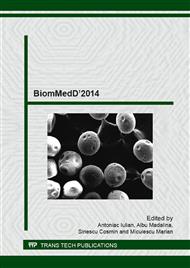[1]
Attin T, Wegehaupt FJ. Impact of erosive conditions on tooth-colored restorative materials. Dent Mater 2013; S0109-5641(13)00181-4.
DOI: 10.1016/j.dental.2013.07.017
Google Scholar
[2]
Wang X, Lussi A. Assessment and Management of Dental Erosion. Dent Clin N Am 2010; 54: 565–578.
Google Scholar
[3]
Ablal MA, Kaur JS, Cooper L, Jarad FD, Milosevic A, Higham SM, Preston AJ. The erosive potential of some alcopops using bovine enamel: An in vitro study. J Dent 2009; 37: 835–839.
DOI: 10.1016/j.jdent.2009.06.016
Google Scholar
[4]
Correr GM, Alonso RCB, Correa MA, Campos EA, Baratto-Filho F, Puppin-Rontani RM. 2009. Influence of diet and salivary characteristics on the prevalence of dental erosion among 12-year-old schoolchildren. J Dent Child 76: 181–187.
Google Scholar
[5]
Elton V, Cooper L, Higham SM, Pender N. 2009. Validation of enamel erosion in vitro. J Dent 37: 336–341.
DOI: 10.1016/j.jdent.2009.01.006
Google Scholar
[6]
Gurgel CV, Rios D, de Oliveira TM, Tessarolli V, Carvalho FP, et al.: A multifactorial analysis of factors associated with dental erosion. Int J PaediatrDent2011; 21: 50–57.
Google Scholar
[7]
Li H, Zou Y, Ding G: Dietary Factors Associated with Dental Erosion: A Meta-Analysis. PLoS ONE 2012; 7(8): e42626.
DOI: 10.1371/journal.pone.0042626
Google Scholar
[8]
Lussi A, Jaeggi T, Zero D: The role of diet in the aetiology of dental erosion. Caries Res 2004; 38(Suppl 1): 34–44.
DOI: 10.1159/000074360
Google Scholar
[9]
Navarro R, Vicente A, Ortiz AJ, Bravo LA: The effects of two soft drinks on bond strength, bracket microleakage, and adhesive remnant on intact and sealed enamel. Eur J Orthod 2011; 33(1): 60-65.
DOI: 10.1093/ejo/cjq018
Google Scholar
[10]
Yip HH, Wong RW, Hägg U: Complications of orthodontic treatment: are soft drinks a risk factor? World J Orthod 2009; 10(1): 33-40.
Google Scholar
[11]
Barbosa CS, Montagnolli LG, Kato MT, Sampaio FC, Buzalaf MAR: Erosion and abrasion of tooth-colored restorative materials and human enamel. J Dent2009; 37(12): 913-922.
DOI: 10.1016/j.jdent.2009.07.006
Google Scholar
[12]
Kato MT, Buzalaf MAR: Iron supplementation reduces the erosive potential of a cola drink on enamel and dentin in situ. J Appl Oral Sci 2012; 20(3): 318-22.
DOI: 10.1590/s1678-77572012000300004
Google Scholar
[13]
Jawale BA, Bendgude V, Mahuli AV, Dave B, Kulkarni H, Mittal S: Dental plaque pH variation with regular soft drink, diet soft drink and high energy drink: an in vivo study. J Contemp Dent Pract 2012; 13(2): 201-214.
DOI: 10.5005/jp-journals-10024-1121
Google Scholar
[14]
Barbosa CS, Kato MT, Buzalaf MAR: Effect of supplementation of soft drinks with green tea extract on their erosive potential against dentine. Aust Dent J 2011; 56(3): 317-321.
DOI: 10.1111/j.1834-7819.2011.01338.x
Google Scholar
[15]
Aliping-McKenzie M, Linden RWA, Nicholson JW: The effect of Coca-Cola and fruit juices on the surfacehardness of glass–ionomers and compomers,. Journal of Oral Rehabilitation 2004; 31: 1046–1052.
DOI: 10.1111/j.1365-2842.2004.01348.x
Google Scholar
[16]
Turssi CP, Hara AT, Domiciano SJ, Serra MC. 2008. Study on the potential inhibition of root dentine wear adjacent to fluoridecontaining restorations. J Mater Sci: Mater Med 19: 47–51.
DOI: 10.1007/s10856-007-3140-4
Google Scholar
[17]
Fatima N, Abidi SY, Qazi FU, Jat SA. Effect of different tetra pack juices on microhardness of direct tooth colored-restorative materials. Saudi Dent J. 2013; 25(1): 29-32.
DOI: 10.1016/j.sdentj.2012.09.002
Google Scholar
[18]
Rios D, Hono´rio HM, Francisconi LF, Magalha˜es AC, Machado MAAM, Buzalaf MAR. 2008. In situ effect of an erosive challenge on different restorative materials and on enamel adjacent to these materials. J Dent 36: 152–157.
DOI: 10.1016/j.jdent.2007.11.013
Google Scholar
[19]
Turssi CP, Hara AT, Domiciano SJ, Serra MC. 2008. Study on the potential inhibition of root dentine wear adjacent to fluoridecontaining restorations. J Mater Sci: Mater Med 19: 47–51.
DOI: 10.1007/s10856-007-3140-4
Google Scholar
[20]
de Carvalho FG, Puppin-Rontani RM, Soares LES, Santo AME, Martin AA, Nociti FH. 2009. Mineral distribution and CLSM analysis of secondary caries inhibition by fluoride/MDPB-containing adhesive system after cariogenic challenges. J Dent 37: 307–314.
DOI: 10.1016/j.jdent.2008.12.006
Google Scholar
[21]
Soares LES, Santo AMD, Brugnera A, Zanin FAA, Martin AA. 2009. Effects of Er: YAG laser irradiation and manipulation treatments on dentin components, part 2: Energy-dispersive X-ray fluorescence spectrometry study. J Biomed Opt 14: 024002-1–024002-7.
DOI: 10.1117/1.3103287
Google Scholar
[22]
Shellis RP, Ganss C, Ren Y, Zero DT, Lussi A: Methodology and Models in Erosion Research: Discussion and Conclusions. Caries Res 2011; 45(suppl 1): 69-77.
DOI: 10.1159/000325971
Google Scholar
[23]
Wan Bakar WZ, McIntyre JM: Susceptibility of Tooth Coloured Dental Materials to Erosion. Saarbrucken, Lambert Academic Publishing, (2010).
Google Scholar
[24]
Soares LE, Lima LR, Vieira Lde S, Do Espírito Santo AM, Martin AA. Erosion Effects on Chemical Composition and Morphology of Dental Materials and Root Dentin Microsc Res Tech. 2012; 75(6): 703-10.
DOI: 10.1002/jemt.21115
Google Scholar
[25]
Yu H, Buchalla W, Cheng H, Wiegand A, Attin T. Topical fluoride application is able to reduce acid susceptibility of restorative materials. Dent Mater J. 2012; 31(3): 433-42.
DOI: 10.4012/dmj.2011-106
Google Scholar
[26]
Wiegand A, Schneider S, Sener B, Roos M, Attin T. Stability against brushing abrasion and the erosion-protective effect of different fluoride compounds. Caries Res. 2014; 48(2): 154-62.
DOI: 10.1159/000353143
Google Scholar
[27]
Domiciano SJ, Colucci V, Serra MC. 2010. Effect of two restorative materials on root dentine erosion. J Biomed Mater Res Part B: Appl Biomater 93B: 304–308.
DOI: 10.1002/jbm.b.31532
Google Scholar
[28]
Lussi A, Lussi J, Carvalho TS, Cvikl B. Toothbrushing after an erosive attack: will waiting avoid tooth wear? Eur J Oral Sci. 2014 Oct; 122(5): 353-9.
DOI: 10.1111/eos.12144
Google Scholar


